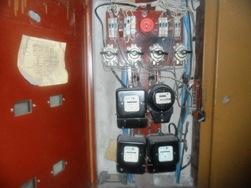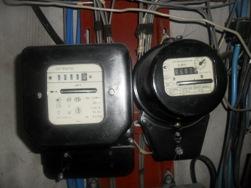Categories: Featured Articles » Electrician at home
Number of views: 76589
Comments on the article: 4
Checking the electricity meter at home
 TOHow can I check the accuracy of the electricity meter, without the help of specialists.
TOHow can I check the accuracy of the electricity meter, without the help of specialists.
This article is intended primarily for those who, by occupation or by character (and mental comfort - the key to a healthy sleep) need to take care of maximum energy savings.
So, if you see, suspect that your meter believes it is incorrect, and this concern intensifies, every time when you give honestly earned money to pay for electricity at the end of the month, then you should conduct a small investigation within your household.
Naturally, the most accurate answer is the work of your electric meter will be given in the metrology laboratory. It costs pretty decent money, and besides, if your suspicions are confirmed, you will have to buy a new meter. Therefore, to begin with, it is better to check it on your own. And in the event that you find that your overpayment for electric energy is significant, then you can buy a new meter with a quiet mind. But this is if the warranty on your device has already expired. And during the warranty period, you just go to the store that sold you low-quality goods, and change it.
Well, you have decided correct metering of electric energy consumption. Where to start? For large industrial enterprises, everything is simple - they have their own metrological services. We do not consider this option. If you are associated with the electrical economy of a non-production organization or a production organization, but not large enough to have a good service of electricians, then you need to do the following.
Get clamp meter. A very useful tool. With it, you can always control the load on your networks. In our case, tongs will be needed to accurately determine the actual power of the current passing through the meter (or through current transformers to which the meter is connected).
For ordinary citizens, who want to deal with the energy consumption at home, but who do not want to buy any kind of device for this, it is not necessary to purchase ticks. We will consider both cases.
 So, we are ready to begin our experiments. What is an electric meter check? The answer is obvious - this comparison of real (actual) electricity consumption with the numbers that the meter board or dial shows us.
So, we are ready to begin our experiments. What is an electric meter check? The answer is obvious - this comparison of real (actual) electricity consumption with the numbers that the meter board or dial shows us.
We can measure the actual consumption with sufficient accuracy only over a rather short period of time, because the load is constantly changing, depending on human activity. Therefore, when checking the meter, the instantaneous (that is, current at a given time) load is measured. This is done in two ways:
1. Using clamp meters.
2. By connecting devices of known power.
In the first case, the current passing in each phase of the network into which the meter is connected is measured. The currents of all the phases involved are summed, the resulting sum is multiplied by 220 - they received the current load.
If there are no clamp meters, then you need to turn on only those devices whose power we know quite accurately. These are ordinary incandescent lamps, an electric kettle, etc. But no energy saving lamps and electric motors! They distort the real picture. It's not hard for an electrician to understand, but believe me - it is.
In general, turn on as many incandescent lamps as possible and add their rated power. Everything else should be turned off. So we measured the real load at a given time. It remains to find out with what to compare it.On the front panel of the meter you will find all the data necessary for analyzing its operation. It:
- a rotating disk, or a pulsating light bulb (indicator);
- gear ratio of the counter - indicated by the letter r or the letter A.
Now we need a stopwatch. Using a stopwatch, we measure the time of a full disk revolution or the time for which the indicator will produce a certain number of pulses (the number of pulses is selected depending on the intensity - the more often it flashes, the more pulses must be taken for greater measurement accuracy). So we measure the load that the meter takes into account. These measurements should be carried out, if possible, simultaneously with the measurement of real load.
Now we will explain how to determine the load from the measured time. What is gear ratio? This is the number of disk revolutions or indicator pulses for which the counter counts one kilowatt * hour. To determine the instantaneous load taken into account by the meter, you need to use the following formula:
P = (3600 * N) / (A * T),
where: T is the time in which N pulses (revolutions) occur, measured in seconds;
A - gear ratio of the counter.
That's all. Now compare the results of both measurements. If there is a noticeable difference, we take measurements several more times to exclude all measurement errors. If the result is confirmed, we make an economic calculation and decide whether to spend money on a new electric meter. Everything is quite simple, if you look. All you need is desire. Save at your pleasure!
See also at bgv.electricianexp.com
:
